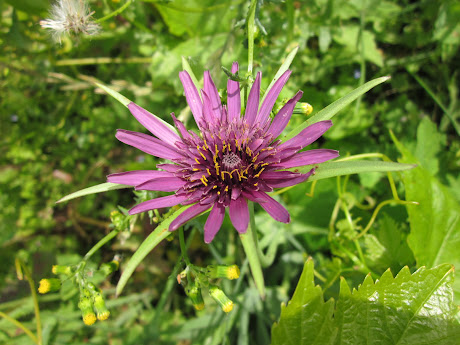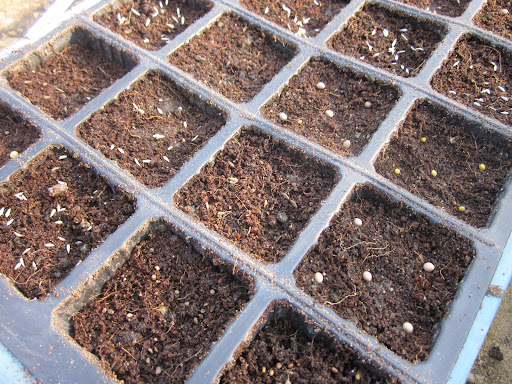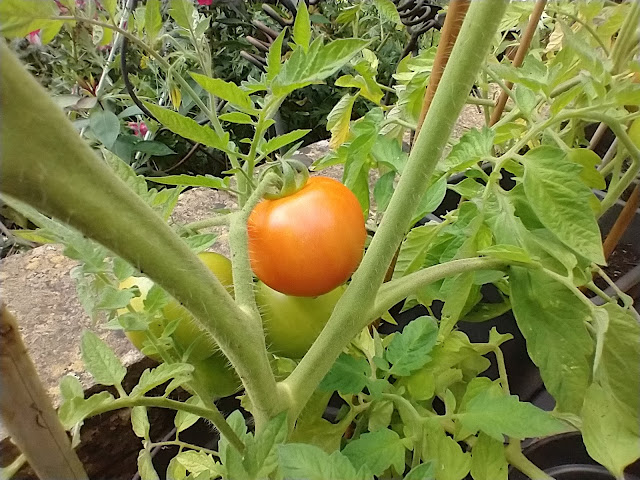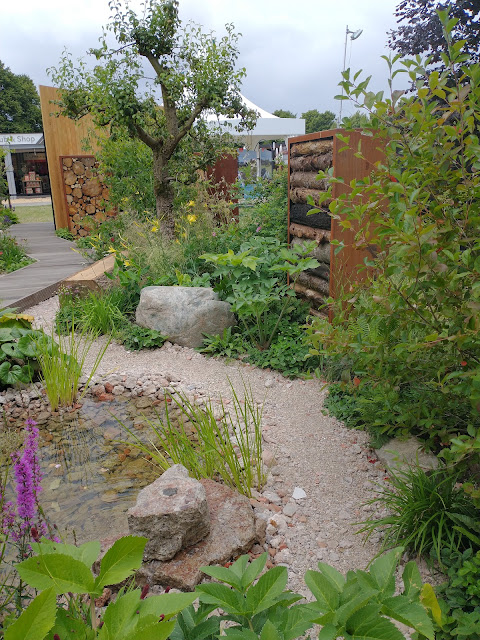Breaking the Rules: Compost Direct
Look at any list of gardening jobs published for this month and I bet most of them - if not all - will have 'make leaf mould' on there. Now leaf mould is a very good thing, but the problem is I have more leaves than my leaf mould bin can take. And like many urban gardeners with a modest plot, I've run out of space to build another one. Besides, when I come to empty it next year, there'd only be a thimble full* of lovely crumbly stuff to use.
This year I've decided to learn from my shady borders in my front and back garden. They're beneath the trees on the public land, so they quickly get covered with a thick layer of leaves in autumn. It means I never have to mulch these borders and all the plants get snuggled down for winter with very little effort on my part.
So I've decided to extend this principle of 'compost direct' to other areas of the garden. Many of my plants - like my dahlias - need mulching in the autumn to protect them from winter's worst and it's allowed them to survive without lifting**. Therefore, the leaves you can see in the above picture will form the start of my dahlia duvet this year.
This isn't so much breaking the rules as ignoring one and placing greater emphasis on another by focusing on the mulching side of things. It also means less effort as I won't have to take the leaves all the way down to the bottom of the garden. Most of them will go on the terrace beds in the middle instead, which are handily placed right by the patio where most of the leaves have accumulated.
My only regret is I haven't thought of this before.
Is there anything you're doing differently this autumn?
* = I might be exaggerating a little for effect ;)
** = don't try this if you garden further north - remember I'm in the softy south. Leaving dahlias to overwinter under a thick layer of protective mulch can be tried south of a line drawn between the Wash and the Severn estuary, but success also depends on your garden's aspect, soil and height above sea level.











I shall be following this with huge interest VP. We did a massive clearing job last year and ended up burning leaves because there was nowhere to store them all. This year, apart from paths and the drive, and maybe the lawn, I plan to leave them where they fall.
ReplyDeleteExcellent Rusty Duck - let's compare notes next year :)
DeleteIt's a good idea. I have some bags of leaves from last year that I think I will get out and spread around. Some things I've read suggest two years for leaf mould, but I'm thinking they should be fine now.
ReplyDeleteHi CJ as you can see Pauline's confirmed leaf mould can take just one year to make. It really depends on where you leave it and how damp the leaves are - they like it pretty wet!
DeleteWe get so many leaves for leaf mould, but even then it isn't enough for what I need. I tend to keep it for mulching round all my snowdrops and any new plants that get planted. We have found that it is ready just a year later, lovely and crumbly. I dig up my dahlias as we in this part of Devon are far too wet for them to survive in the soil over winter, I've lost far too many to leave them in any more.
ReplyDeleteYes Pauline, even with my method there won't be enough to mulch everything. The dahlias and fuchias will get first dibs. I have a clay soil, but the terracing means these beds are fairly well drained. I've found their walls give some extra shelter too.
DeleteYou're right, leaf mould is wonderful stuff, but I've found a bin full rots down to about 1ft depth at most. It doesn't go very far :(
As well as gathering industrial quantities of leaves from the wood to fill the leaf mould bins, I also use the "leaf duvet" method on a number of flower beds - so I can assure you it works :)
ReplyDeleteAnd yes, it can be made in a year, especially if you gather them by lawn mower so they are chopped up, with a bit of grass to accelerate the process
Last month I dug out enough leaf mould from last years leaf bins to fill 2 of the one tonne builders bags
*smug grin*
I'll get my coat...
Hi Sarah - these are all very good tips, thanks for sharing them :)
DeleteSounds an eminently sensible idea using nature's free bounty VP. Would that I were not well north of that line :) I always add a handful or two of my previous year's leaf mould into any of my special snowdrops as I'm potting them up. It's not rotted down at that stage but the snowdrops appreciate it.
ReplyDeleteIt's interesting to see two mentions of snowdrops in the comments Anna. Most of mine are in the front side garden, so they must have benefited from my compost direct method without me realising how good it is for them.
DeleteAfter moving house we have inherited a very unloved garden - more than we realised.
ReplyDeleteThere is so much rubbish to clear, but the constant rain hasn't helped our efforts. We lifted slabs and made a start on where we want our veg patch and dumped a load of compost items/bags of soil (that were around) and chicken manure onto it. It still needs a really good dig over as the amount of stones & concrete bits in the soil was shocking.
We just restarted the compost bin, it was full of brambles and too compacted that nothing was composting well. So here's hoping we get some dry weather to clear up the garden, for some reason it is very muddy down the bottom of the garden, the poor chickens were really suffering, but have made big progress to cort them out, still a way to go!
Hi Sarah and welcome :) It sounds like you have lots to do but you're enjoying it.
DeleteI only get Rowen leaves in my garden, but fortunately the garden I help out in has lots of leaves. I bagged up loads last year so will be lugging them down the hill this weekend. I have a few tender plants that I just can't dig up, so mulch is essential. I tend to try to keep them in place with a thin layer of soil. Happy leaf spreading!
ReplyDeleteHaving seen that hill Dobby, I know you have lots of hard work ahead!
DeleteYou have reminded me that I need to check on last year's leaves, if I can get at the bags - the fence that fell down is currently "resting" on them. I really like the idea of using the leaves as a mulch, much like Anne Wareham's policy of cutting perennials down and letting them lie in place as a mulch at Veddw. Most of our leaves lie in piles all over the drive, so I plan to hoover them up and start some new bags/bins. And definitely mulch the dahlias with some our own compost. I'd do the same as you with the leaves but I am wanting to encourage some self-seeding, so bagging up it is!
ReplyDeleteHi Janet - I use my perennials as a mulch too - though I shred mine first. This year's dahlias will feed 2014's!
DeleteNice idea, I'm all for the breaking a few rules, try it and see approach.
ReplyDeleteGreg - welcome! That's exactly what this series is encouraging - let's have more of try it and see, and where there is a 'rule', understand it more.
DeleteAnd here's the relevant post: great minds thinking alike! http://veddw.com/blog/just-cut-it-down/
ReplyDeleteXxx
Thanks Anne - you'll see from the comments above that I advocate mulching rather than composting too.
DeleteIt's also much better for the soil, as one of the major causes of compaction is rainfall, and the leaves protect the surface from full imact. We just make work for ourselves, don't we?
ReplyDeleteThat's a useful nugget of information, thanks Helen :)
DeleteI've been "breaking" this rule for years. When others are bagging up their leaves and leaving them on the curb for municipal composting, I'm busily raking my leaves onto my garden beds. In spring (round about April for us), I pry back the bed of leaves from the crowns of any plants that might need it. By midsummer, all the leaves have been eco-incorporated into the ground. Sometimes I shred them, which makes them easier to break down and less likely to blow away. This is in Canada. My grandmother in Wales (she of the locally prizewinning garden) had no compost bin, and tipped everything – potato peelings, tea leaves, chop bones – right onto her sandy soil, washed down with dishwater. Her garden thrived. So go to it, VP!
ReplyDeleteI love the sound of your grandmother Helen, she had the right idea re her sandy soil :)
DeleteThis, and cutting down perennials and other plants down where they stand and leaving the debris has been our practice at Veddw for some 20 years. We have great soil as a result and of course it's easier than carting it all off to a compost heap, just to cart it all back. Leaves that are anywhere else than on the beds get left to the wind or the mower to redistribute, the mower then giving the bit extra for any empty spaces. Never have bare soil! Xxx
ReplyDeleteI wonder how that works in a garden where self-seeders are encouraged Anne? Not that I have that kind of garden, just curious ;)
Delete